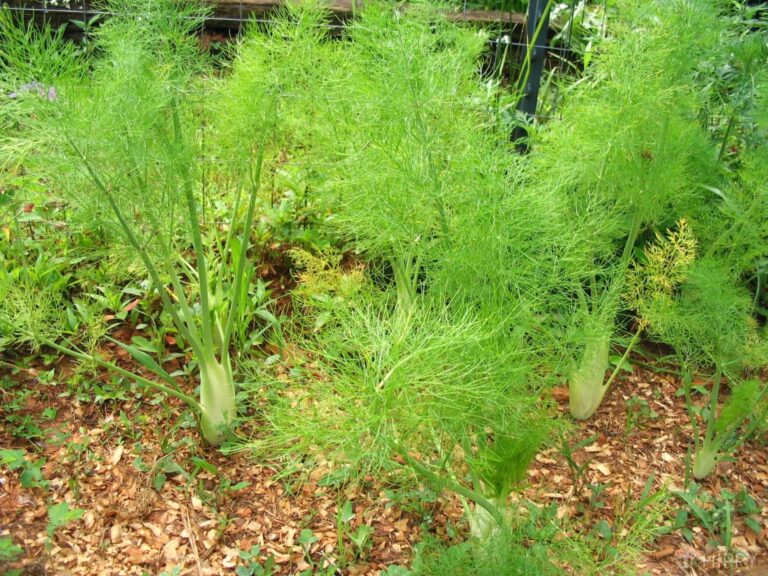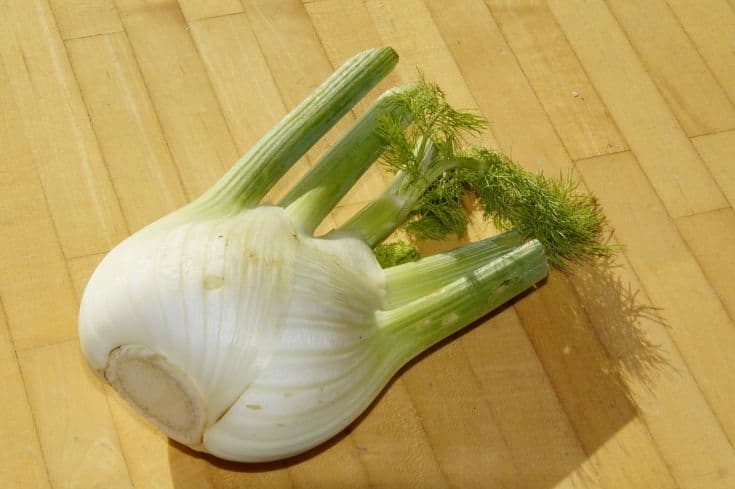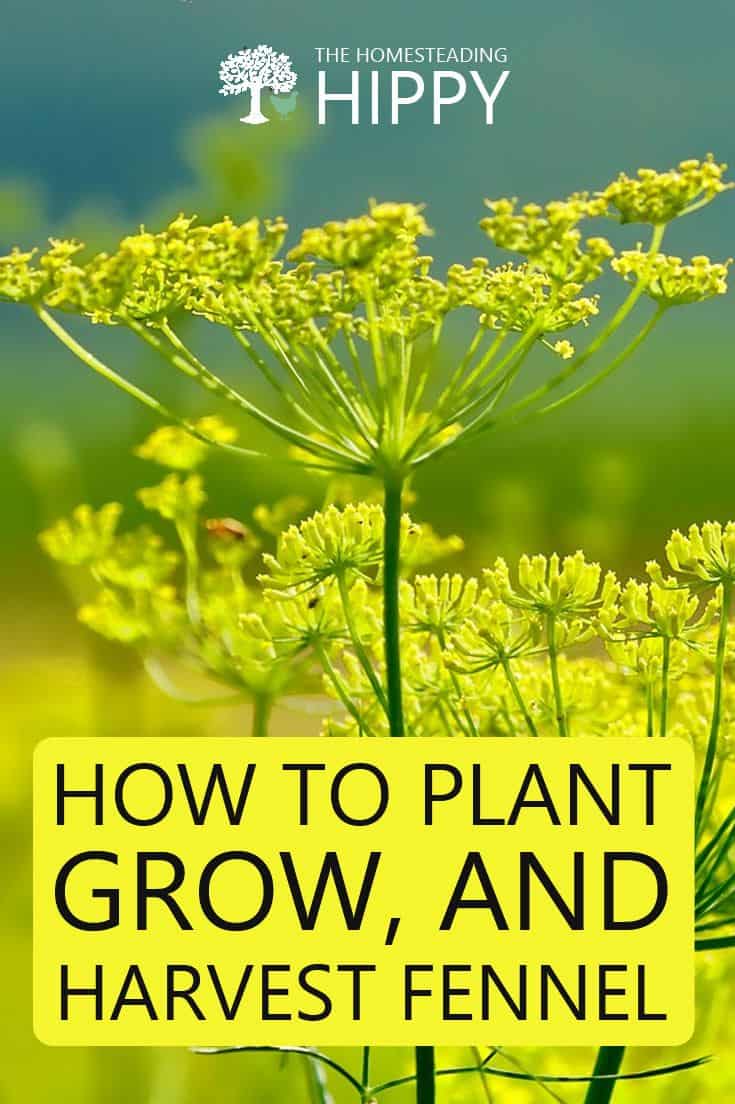This year, one of my main gardening goals was to learn how to plant, grow, and harvest fennel – along with a number of other culinary herbs.

Some of my other herbs (especially the lemon balm) have done quite well, and although my fennel is still holding its own, it hasn’t quite gone through the explosive growth process that the other herbs have as of yet.
Some plants just take a little more time to get started, and fennel is one of them…
Once the weather really warms up and summer kicks into full force, I have no doubt that I’ll be harvesting tons of fennel in no time.
Table of Contents
Why You Should Grow Fennel
If you’re new to herb gardening, you should consider these tips for growing fennel. It’s a fantastic herb that every cook should have in his or her potager garden!
The fennel herb, also known as Foeniculum vulgare, has quite a long and colorful history of its use.
Both the Chinese and Egyptians used this plant for its medicinal purposes, and during the Middle Ages, people believed that fennel possessed magical qualities. They would use it to drive away evil spirits!
I’ll be honest – that’s not one of my preferred uses for the herb, although I guess that’s good to know. Instead, I like to use this herb as a seasoning for fish and eggs. It has a sharp flavor that makes it delicious for use in things like baked goods, too.
The plant is native to southern Europe, but you can grow it in your garden (or even indoors or in a container) just about anywhere you live.
Fresh fennel, whether you’re using the seeds or the leaves, is loaded with nutrients. It’s high in manganese as well as other nutrients like vitamin C, calcium, magnesium, potassium, iron, and more.
Varieties of Fennel
There are essentially two types of fennel you can grow in your garden – common fennel and Florence fennel.
Common fennel produces large branches that can reach up to five feet in height. The Plant produces large, flat clusters of yellow flowers that bloom in the summer and attract butterflies.
You’ll find several cultivars of this variety, including:
- “Bronze,”
- “Smokey,”
- “Rubrum,”
- and “Purpureum.”
All are hardy in zones 4 through 9.
Florence fennel is a bit smaller than common fennel and rarely reaches more than two or three feet in height. It has a bulbous leaf stalk that you can harvest and eat either raw or cooked.
The most popular cultivars of Florence fennel are Zefa Fino and Trieste. This kind of fennel is hardy in zones 5 to 9.
Planting Fennel from Seed
There are essentially two main ways you can grow fennel – you can start it from seed or you can grow it as a division.
Most people choose the seed method because dividing fennel plants is not as easy as it is to divide other garden plants. The plant has a long taproot that doesn’t like to move or mess with.
Therefore, I plant my fennel by seed. You can sow your seed as soon as the weather warms in the spring. Soak the seeds for a couple of days before you plant, which will help improve their germination.
You will want to keep the soil moist until they sprout, too. Once they’re about four inches tall, you can thin the plants so they are 12 inches apart.
Where to plant your seeds? The best spot to plant fennel is in a sunny location, preferably in a bed that has well-draining soil.
Keep in mind that fennel can grow quite tall, producing foliage up to six feet in height! Although it produces a gorgeous backdrop in this sense, you do need to make sure it’s not overshadowing your other plants.
Fennel prefers slightly acidic soil, so consider amending your garden soil ahead of time, before you plant.
Transplanting Fennel
You can also start fennel seeds inside, and then transplant them outdoors. You’ll follow the same sowing procedures mentioned above, except you should do this by sowing thinly in seed starting trays. You can thin to one plant per cell when they get large enough.
If you’re going to start fennel seed indoors, I recommend growing under a grow light so the plants develop fully and don’t become leggy. Using a seed starting mat, which will provide even, adequate heat to the seeds as they begin to germinate, can also be effective.
Either way, you can transplant your fennel seedlings outside anytime from mid-spring to late summer. You will want to transplant when your plants are less than six weeks old and four inches tall. Any time after this, they may become root-bound. It will be hard for you to transplant without disturbing the roots.
When you plant, make sure the plants are spaced at least six inches apart. They can be planted in single rows or in rows that are 18” apart.
Caring for Fennel Plants
Watering
The best way to care for your fennel plants is to keep the soil adequately moist by watering regularly. You will need to water more often during hot, dry periods.
The soils should remain consistently moist. It’s especially important that you mind your watering when the plants are first getting established.
Weeding
Do your best to keep the soil around your fennel plants weed-free. Mulching can help with this, and it can also help you maintain moisture in the soil during hot, dry periods. Use an organic mulch that won’t heat up the soil too much, like straw or hay mulch.
Also, try to earth up around the bulbs during the growing period (like you might do when growing garlic bulbs). This will help prevent them from getting dried out and will lend them a sweet, nutty flavor and crunchy texture.
You will plant fennel after the last spring frost, but keep in mind that the plant is not very frost-tolerant. Although it can handle the occasional light frost, it will need protection when it’s young.
If you accidentally plant too soon and a frost is in the forecast, use a frost cloth to cover it up and protect it from the elements.
Fertilizing
Although fertilizing fennel isn’t necessary, you will get better yields out of your plants by fertilizing with a complete fertilizer after they reach about a foot in height.
To do this, just spread a tablespoon or two of fertilizer onto the soil surrounding the plant, and then water well.
Once blossoms appear on your plant, you can either punch them off to prevent the flower from going to seed, or leave them be – the plant will attract beneficial insects once it has flowered.
Pests and Diseases
Fennel is closely related to plants like caraway, dill, cumin, carrots, and parsley – it’s in the same family.
Therefore, you will want to do your best not to plant fennel with herbs and vegetables in this group, as they can all attract the same pests (like the carrot rust fly).
You also need to be mindful of planting dill near your fennel plants. Not only are the two plants closely related, but it is possible for cross-pollination to leave your fennel tasting strange and unappetizing. The same is true for your dill.
Another problem that you may notice is the parsley worm. This pest attacks all kinds of plants in the carrot family, and it looks like a green caterpillar with yellow and black stripes.
Check your plants on a regular basis and remove the worms when you see them. Otherwise, they’ll eat the foliage.
Otherwise, you don’t have to worry about too many pests and diseases. The most common pest that tends to congregate on fennel is the aphid.
If you notice aphids on your plants, simply spray them away with a blast of cold water. You can also use insecticidal soap, but this isn’t usually necessary.
When it comes to diseases, you may notice a few fungal issues, but these are rare, especially if you follow good spacing recommendations and watering hygiene.
Just watch out for things like powdery mildew and downy mildew, which are easily preventable with proper spacing.
Fennel Companion Plants
Fennel is often grown as a companion plant for other species. It attracts all kinds of beneficial insects, including many pollinators.
It can also attract certain predatory insects, like parasitic wasps and ladybugs. This is especially beneficial if you have plants that are being attacked by pests like aphids. The predators will feed upon the pests without you having to do any work on your part.
Otherwise, fennel isn’t a great companion plant for other plants in your garden in a traditional sense. It grows so large and aromatic that it can sometimes overpower nearby plants.
Growing Fennel in a Container or Indoors
If you don’t have a lot of space in your garden, don’t worry – you can easily grow fennel in a container. You will want to make sure you choose a pot that is large enough, as fennel produces a large taproot that requires lots of depth.
Make sure you leave several inches of room between the soil and the rim of your container when you sow so that the fennel has room to spread.
Follow all other spacing and planting recommendations. Make sure you keep your fennel plants well-watered, as it is easy for containers to dry out if you aren’t careful. Water whenever the top inch of soil becomes dry.

Harvesting Fennel
A short-lived perennial, fennel blooms best in its second year. It reseeds itself aggressively and although it’s not invasive, it will spread rapidly. You will want to cut fennel early in the harvest season to help make sure it continues to grow in a bushy fashion.
You can also deadhead it for seed harvest. This will help prevent the plant from overseeding new plants, too.
Simply harvest and dry the seeds as the flower heads fade back. You will know that your leaves are ready for harvest when they are green – you can harvest leaves throughout the entire growing season.
Avoid any leaves that appear to be brown, as they won’t have a great flavor.
If you’re harvesting seeds, you will want to tie some small bags over the seed heads. Leave them there for a few days, then shake the heads. This will release seeds into the bags. You can then remove them carefully.
If you’re harvesting fennel bulbs, wait until they are about three inches in diameter. Wait any longer, and they can become tough. Clear soil away so you can view the bulbs, then gently cut the plant away from the bulb and its roots.
Storing and Preserving Fennel
Once you harvest your fennel leaves, you can keep them on the counter with the cut stems in a glass of water.
You’ll want to make sure you don’t harvest any more than a third of the plant when you cut the leaves – not only can it weaken the plant, but it will also give you way more fennel than you know what to do with!
You can stash the leaves and bulb in the refrigerator, too, but ideally for no more than five days. Fennel leaves can be dehydrated for later use as well. Some people freeze fennel, but I’ve always found the leaves to be limp and flavorless after doing this.
How to Use Fennel
You can use both the seeds and the leaves of fennel in your cooking. They both have a sweet flavor of anise that tastes much like licorice, and is wonderful in everything from soups and stews to salads.
You can slice up the tee bulbs and use them in side dishes and salads, or you can roast them, which will lend the fennel a strong, deep flavor.
You can even eat fennel flowers! They are beautiful garnishes for meat and fish dishes. Plus, they look great in bouquets.
I’m excited to see how well my fennel does this year in the garden. Although it took some time to get going – I blame that on the late spring snows and lingering frosts that delayed planting.
I think fennel has the potential to be a real superstar in my garden this summer! What about yours?


Rebekah is a full-time homesteader. On her 22 acres, she raises chickens, sheep, and bees, not to mention she grows a wide variety of veggies. She has a huge greenhouse and does lots of DIY projects with her husband in her ever-growing homesteading endeavor. Learn more about Rebekah here.

Great article! love fennel and will definitely use the info.
stay safe:)
Thanks. Have fennel that comes back ever year into lovely yellow flower heads. Looking to save seed this year.
The Eastern Black Swallowtail butterfly will eat fennel and parsley and it is the worm you mentioned on Pest and diseases. It is a caterpillar with yellow and black stripes.
Yes we get the Swallowtail Butterflies and their caterpillar every year on a few of our parsley plants, we grow extra for this reason. Beautiful to observe the birth of the butterfly from the cocoon.
I have two fennel clumps that are around 40 years old. They need to be moved to a more suitable location because they have been almost smothered by liriope. I’m thinking early winter would be a good time for doing this but I’m unsure how to handle them. Should they be cut back before moving? Thank you.